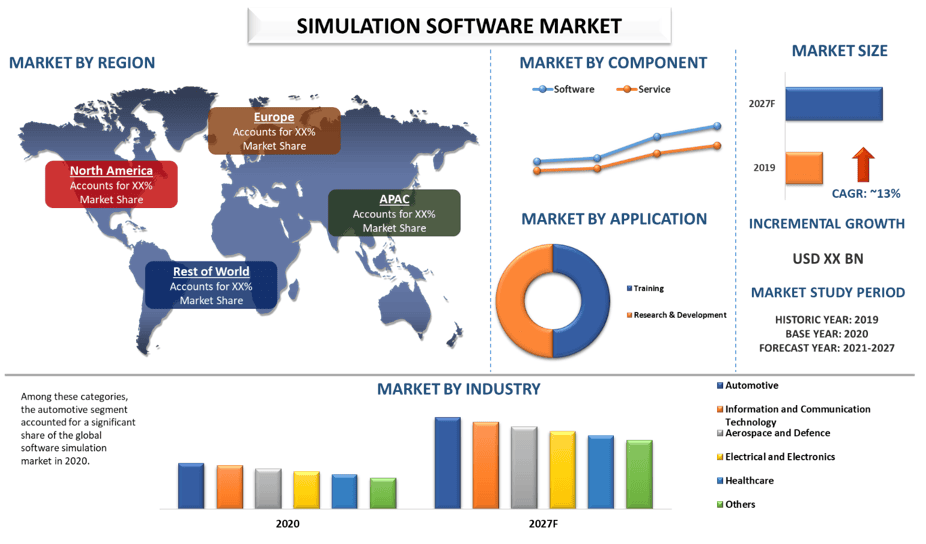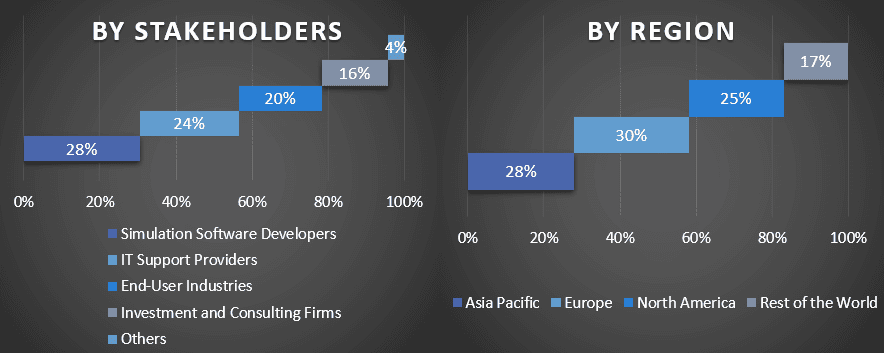- Accueil
- À propos de nous
- Industrie
- Services
- Lecture
- Contactez-nous
Marché des logiciels de simulation : Analyse et prévisions actuelles (2021-2027)
Mise en évidence des composants (logiciels et services) ; Déploiement (Cloud et sur site) ; Application (Formation et Recherche et Développement) ; Industrie (Automobile, Technologies de l'information et de la communication, Aérospatiale et Défense, Électricité et Électronique, Santé, et Autres) ; et Région/Pays

DEMANDER UN EXEMPLE PDF GRATUIT
Le marché mondial des logiciels de simulation devrait enregistrer un TCAC d'environ 13 % sur la période 2021-2027. Le marché mondial des logiciels de simulation est en hausse en raison de la demande croissante d'une solution efficace pour réduire les dépenses de production et les coûts de formation, ainsi que de l'adoption significative de la simulation dans l'industrie aérospatiale et de la défense. De plus, une augmentation de l'utilisation des logiciels de simulation dans l'industrie automobile et de la santé, suivie d'une demande croissante d'un environnement de travail respectueux de l'environnement, stimulera positivement le paysage de l'industrie. Un logiciel de simulation est un programme qui permet à une entreprise de créer un processus factice et d'observer le fonctionnement sans l'exécuter. Cela permet de tester le même système ou un système modifié avec différentes entrées et de suivre et d'analyser la réponse. Les logiciels de simulation sont souvent utilisés dans la conception d'usines pour s'assurer que le produit final se rapproche des spécifications de conception sans changements de processus coûteux. De nombreuses entreprises des secteurs de l'aérospatiale, de la défense et de l'automobile ont massivement investi dans la recherche pour développer la reconnaissance d'images et les applications connexes. Par conséquent, le marché des logiciels de simulation est susceptible de croître à un rythme influent au cours de la période de prévision. La nécessité de logiciels de simulation sera stimulée en raison de leur capacité à évaluer, comparer et optimiser des conceptions, des plans et des politiques alternatives. En outre, le marché augmentera en raison des capacités croissantes de la simulation concernant les technologies de pointe telles que les jumeaux numériques, la réalité augmentée/réalité virtuelle et l'impression 3D.
MathWorks Inc., Autodesk Inc., ANSYS Inc., Siemens AG, Dassault Systèmes SE, Altair Engineering Inc., Hexagon AB, Honeywell International Inc., AVEVA Group PLC, Bentley Systems International Limited sont quelques-uns des acteurs clés du marché. Plusieurs fusions et acquisitions ainsi que des partenariats ont été entrepris par ces acteurs pour fournir aux clients des produits/technologies de haute technologie et innovants.
Aperçus présentés dans le rapport
« Parmi les déploiements, la catégorie sur site détenait une part importante du marché en 2020 »
En fonction du déploiement, le marché des logiciels de simulation est segmenté en cloud et sur site. Le segment sur site détenait une part importante du marché des logiciels de simulation en 2020 et devrait connaître un TCAC robuste au cours de la période de prévision. L'un des principaux facteurs de croissance du segment sur site est la fonction de protection des données du déploiement sur site. Les données de l'entreprise sont stockées localement sur site, et l'entreprise a le contrôle total des données et de leur sécurité. De plus, si des problèmes de réseau surviennent et que la connexion à Internet est interrompue, les employés peuvent toujours accéder aux données avec des solutions sur site.
« Parmi les applications, le segment de la formation et de la recherche et du développement détenait une part importante du marché en 2020 »
En fonction de l'application, le marché des logiciels de simulation est classé en formation et recherche et développement. Parmi les deux catégories, le segment de la recherche et du développement a représenté une part importante du marché mondial des logiciels de simulation en 2020 et devrait afficher une croissance substantielle au cours de la période de prévision. La croissance de ce segment peut être attribuée à l'adoption de logiciels de simulation par certaines des principales entreprises des secteurs de l'automobile, de l'aérospatiale et de la défense, de la santé et d'autres secteurs à des fins d'ingénierie de produits, de modélisation, de recherche et de développement.
« L'Amérique du Nord devrait connaître une croissance significative au cours de la période de prévision »
L'Amérique du Nord devrait connaître un TCAC important au cours de la période de prévision. La croissance de ce marché peut être attribuée aux investissements croissants dans les activités de recherche et de développement pour l'introduction de produits technologiquement avancés dans la région. De plus, les gouvernements nord-américains se concentrent constamment sur l'innovation et l'investissement pour un environnement de travail plus respectueux de l'environnement. Dans cette région, les réglementations relatives à l'environnement de travail respectueux de l'environnement sont devenues plus strictes, et par conséquent, les entreprises utilisent des simulateurs pour tester la faisabilité de leurs produits avant leur fabrication. De plus, les initiatives gouvernementales en matière de villes intelligentes dans la région ont également eu un impact positif sur l'acceptation des techniques de simulation et d'analyse pour améliorer et renforcer les capacités de surveillance. Les capacités croissantes de la simulation concernant les technologies de pointe telles que les jumeaux numériques, la réalité augmentée/réalité virtuelle et l'impression 3D augmentent la croissance du marché des logiciels de simulation dans la région.
Raisons d'acheter ce rapport :
- L'étude comprend une analyse de dimensionnement et de prévision du marché validée par des experts clés de l'industrie authentifiés.
- Le rapport présente un aperçu rapide des performances globales de l'industrie en un coup d'œil.
- Le rapport couvre une analyse approfondie des principaux acteurs de l'industrie, en mettant l'accent principal sur les indicateurs financiers clés des entreprises, le portefeuille de produits, les stratégies d'expansion et les développements récents.
- Examen détaillé des moteurs, des contraintes, des principales tendances et des opportunités prévalant dans l'industrie.
- L'étude couvre de manière exhaustive le marché sur différents segments.
- Analyse approfondie du niveau régional de l'industrie.
Options de personnalisation :
Le marché mondial des logiciels de simulation peut en outre être personnalisé selon les exigences ou tout autre segment de marché. En outre, UMI comprend que vous pouvez avoir vos propres besoins commerciaux, n'hésitez donc pas à nous contacter pour obtenir un rapport qui correspond parfaitement à vos besoins.
Table des matières
Méthodologie de recherche pour l'analyse du marché des logiciels de simulation (2021-2027)
L'analyse du marché historique, l'estimation du marché actuel et la prévision du marché futur du marché mondial des logiciels de simulation ont été les trois étapes majeures entreprises pour créer et analyser l'adoption des logiciels de simulation dans les principales régions du monde. Des recherches secondaires exhaustives ont été menées pour collecter les chiffres historiques du marché et estimer la taille actuelle du marché. Deuxièmement, pour valider ces informations, de nombreuses constatations et hypothèses ont été prises en considération. De plus, des entretiens primaires exhaustifs ont également été menés avec des experts de l'industrie à travers la chaîne de valeur du marché mondial des logiciels de simulation. Après l'hypothèse et la validation des chiffres du marché grâce à des entretiens primaires, nous avons utilisé une approche descendante/ascendante pour prévoir la taille complète du marché. Par la suite, des méthodes de ventilation du marché et de triangulation des données ont été adoptées pour estimer et analyser la taille du marché des segments et sous-segments auxquels l'industrie appartient. La méthodologie détaillée est expliquée ci-dessous :
Demander plus de détails sur la méthodologie de recherche
Analyse de la taille historique du marché
Étape 1 : Étude approfondie des sources secondaires :
Une étude secondaire détaillée a été menée pour obtenir la taille historique du marché du marché des logiciels de simulation par le biais de sources internes de l'entreprise telles querapport annuel et états financiers, présentations de performance, communiqués de presse, etc.,et sources externes, y comprisjournaux, actualités et articles, publications gouvernementales, publications des concurrents, rapports sectoriels, bases de données tierces et autres publications crédibles.
Étape 2 : Segmentation du marché :
Après avoir obtenu la taille historique du marché du marché des logiciels de simulation, nous avons mené une analyse secondaire détaillée pour recueillir des informations historiques sur le marché et les parts pour différents segments et sous-segments pour les principales régions. Les principaux segments inclus dans le rapport en tant que composant, déploiement, application et industrie. D'autres analyses au niveau des pays ont été menées pour évaluer l'adoption globale des modèles de test dans cette région.
Étape 3 : Analyse des facteurs :
Après avoir acquis la taille historique du marché des différents segments et sous-segments, nous avons mené une analyse détailléeanalyse factoriellepour estimer la taille actuelle du marché du marché des logiciels de simulation. De plus, nous avons mené une analyse factorielle en utilisant des variables dépendantes et indépendantes telles que divers composants, déploiements, applications et industries de logiciels de simulation. Une analyse approfondie a été menée pour les scénarios d'offre et de demande en tenant compte des principaux partenariats, fusions et acquisitions, expansion des activités et lancements de produits dans le secteur du marché des logiciels de simulation à travers le monde.
Estimation et prévision de la taille actuelle du marché
Dimensionnement actuel du marché :Sur la base d'informations exploitables tirées des 3 étapes ci-dessus, nous sommes arrivés à la taille actuelle du marché, aux principaux acteurs du marché mondial des logiciels de simulation et aux parts de marché des segments. Toutes les parts de pourcentage requises fractionnées et les ventilations du marché ont été déterminées à l'aide de l'approche secondaire mentionnée ci-dessus et ont été vérifiées lors d'entretiens primaires.
Estimation et prévisions :Pour l'estimation et les prévisions du marché, des pondérations ont été attribuées à différents facteurs, y compris les moteurs et les tendances, les contraintes et les opportunités disponibles pour les parties prenantes. Après avoir analysé ces facteurs, des techniques de prévision pertinentes, c'est-à-dire l'approche descendante/ascendante, ont été appliquées pour parvenir à la prévision du marché d'ici 2027 pour différents segments et sous-segments sur les principaux marchés du monde. La méthodologie de recherche adoptée pour estimer la taille du marché englobe :
- La taille du marché de l'industrie, en termes de chiffre d'affaires (USD) et le taux d'adoption du marché des logiciels de simulation sur les principaux marchés nationaux
- Toutes les parts de pourcentage, les fractionnements et les ventilations des segments et sous-segments de marché
- Les principaux acteurs du marché mondial des logiciels de simulation en termes de solutions offertes. De plus, les stratégies de croissance adoptées par ces acteurs pour être compétitifs sur le marché en croissance rapide
Validation de la taille et de la part du marché
Recherche primaire :Des entretiens approfondis ont été menés avec les principaux leaders d'opinion (KOL), y compris les dirigeants de haut niveau (CXO/VP, responsables des ventes, responsables du marketing, responsables opérationnels et responsables régionaux, responsables pays, etc.) dans les principales régions. Les résultats de la recherche primaire ont ensuite été résumés et une analyse statistique a été effectuée pour prouver l'hypothèse énoncée. Les données issues de la recherche primaire ont été consolidées avec les résultats secondaires, transformant ainsi l'information en informations exploitables.
Répartition des participants primaires dans les différentes régions

Ingénierie de marché
La technique de triangulation des données a été employée pour compléter l'estimation globale du marché et pour parvenir à des chiffres statistiques précis de chaque segment et sous-segment du marché mondial des logiciels de simulation. Les données ont été divisées en plusieurs segments et sous-segments après avoir étudié divers paramètres et tendances dans les domaines des composants, du déploiement, des applications et de l'industrie sur le marché mondial des logiciels de simulation.
L'objectif principal de l'étude de marché mondiale des logiciels de simulation
Les tendances actuelles et futures du marché mondial des logiciels de simulation ont été identifiées dans l'étude. Les investisseurs peuvent obtenir des informations stratégiques pour baser leur discrétion pour les investissements à partir de l'analyse qualitative et quantitative effectuée dans l'étude. Les tendances actuelles et futures du marché ont déterminé l'attractivité globale du marché au niveau régional, fournissant une plate-forme pour les acteurs industriels afin d'exploiter le marché inexploité pour en bénéficier en tant qu'avantage du premier arrivé. D'autres objectifs quantitatifs des études comprennent :
- Analyser la taille actuelle et prévue du marché des logiciels de simulation en termes de valeur (USD). De plus, analyser la taille actuelle et prévue du marché des différents segments et sous-segments
- Les segments de l'étude comprennent les domaines des composants, du déploiement, des applications et de l'industrie
- Définir et analyser le cadre réglementaire pour l'industrie des logiciels de simulation.
- Analyser la chaîne de valeur impliquée avec la présence de divers intermédiaires, ainsi qu'analyser les comportements des clients et des concurrents de l'industrie.
- Analyser la taille actuelle et prévue du marché des logiciels de simulation pour la région principale.
- Les principaux pays des régions étudiées dans le rapport comprennent l'Asie-Pacifique, l'Europe, l'Amérique du Nord et le reste du monde.
- Profils d'entreprises du marché des logiciels de simulation et stratégies de croissance adoptées par les acteurs du marché pour se maintenir sur le marché en forte croissance
- Analyse approfondie du niveau régional de l'industrie
Connexes Rapports
Les clients qui ont acheté cet article ont également acheté










